Immigration has greatly influenced the economic and cultural development of our state. Facts about the backgrounds, circumstances, and experiences of Minnesota’s immigrants have changed considerably over time, and differ from the nation as a whole.
Minnesota is home to over 400,000 immigrants from around the world.
Immigrants make up about 8 percent of Minnesota’s population, a smaller but more diverse group than in the past and compared to the U.S. as a whole. Until the 1970s, most immigrants coming to Minnesota hailed from western Europe, primarily Germany, Norway, and Sweden. Today, our largest immigrant groups are from Mexico, India, Laos, Somalia, and Vietnam.
Minnesota has a much larger proportion of Asian and African immigrants than the nation. For example, 22 percent of our foreign-born residents are from Africa, compared to 5 percent nationally. While over half of all immigrants nationwide are from Latin America, only about a quarter of Minnesota’s immigrants come from that region.
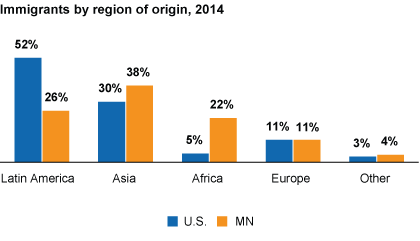
Our state has long been a welcoming community for refugees, which has shaped our uniquely diverse immigrant population. Since 2000, more than 41,000 refugees have arrived in Minnesota as their first destination in the United States. And our state is the top state for refugees who relocate from another state, usually within three months of arrival to the U.S.
Our newly updated group-at-a-glance profiles for Minnesota’s 11 largest immigrant groups demonstrate diversity in a variety of ways. Some of our largest immigrant groups have a longer-standing presence in Minnesota than others. The majority of Minnesota’s Chinese, Ethiopian, and Indian immigrants have lived in the U.S. ten years or less, while the majority of Minnesota’s Hmong, Korean, and Laotian immigrants have lived in the U.S. longer than 20 years. Our profiles also show great diversity in education, income, and language skills.
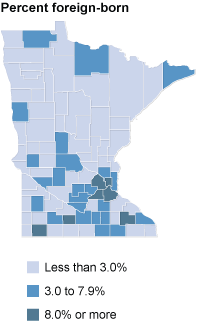
Most immigrants live in the Twin Cities, but there are pockets of immigrant communities in greater Minnesota
About 80 percent of immigrants live in the Twin Cities area, many in well-established immigrant communities in several Minneapolis and Saint Paul neighborhoods. However, a growing proportion of immigrants have settled in the suburbs. In 1950, about half of immigrants in the Twin Cities lived in the suburbs; today 65 percent do.
Among the 20 percent of immigrants who live in greater Minnesota, most are concentrated in areas where they have found employment opportunities. For example, the county with the greatest share of its population coming from abroad is Nobles County in Southern Minnesota, which first attracted immigrants to move there for meat processing jobs. Now, immigrants have become part of the fabric of the community, working in a variety of fields.
Overall, employment rates for immigrants mirror the state, but poverty rates are higher
Seventy-two percent of Minnesota’s foreign-born adults are working, just shy of employment among native-born adults (at 77%). But immigrant employment varies by birthplace, gender, and years in the U.S. For example, 78 percent of foreign-born adults who have been in the U.S. for longer than 20 years are working, compared to 57 percent of adults who have been here for 5 years or fewer.
While employment for immigrants is similar to all Minnesotans, a greater share of immigrants live in poverty: 21 percent of immigrants in Minnesota live below the poverty level, compared to 12 percent of all Minnesotans. But here again we see considerable variation, with poverty rates ranging from 4 to 55 percent across the state’s largest immigrant groups.
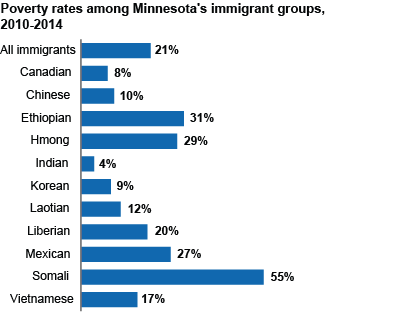
Median household income ranges from $18,200 among Somali immigrant-headed households to $96,900 among Indian immigrant-headed households.
In general, immigrant groups with higher poverty rates have lower levels of education. Close to half of all adult immigrants have a high school degree or less, but this ranges from 6 percent among Indian immigrants to 80 percent among Mexican immigrants. About a third of all adult immigrants have a bachelor’s degree or higher, but this ranges from 9 percent of Laotian and Somali immigrants to nearly 90 percent of Indian immigrants – including the incredible 48 percent who hold advanced degrees.
Children of immigrants are a growing share of our population and, as a result, of our emerging workforce
One in six children in Minnesota has a foreign-born parent, and the vast majority of these children are native-born themselves. The number of native-born children with at least one foreign-born parent has more than doubled since 2000, while the number of foreign-born children living in Minnesota has remained relatively steady. Interestingly, about one in five of Minnesota’s foreign-born children is an international adoptee, many originally from China and Korea.
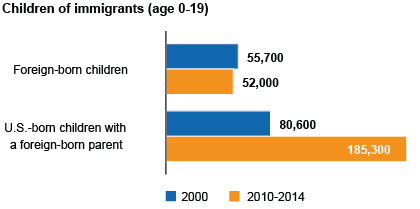
These trends suggest that children of immigrants are a growing segment of our emerging workforce. The ability to speak a foreign language can be a strength in our increasingly global economy, and 15 percent of students enrolled in Minnesota’s public schools speak a language other than English at home. Two-thirds of these students speak Spanish, Somali, or Hmong. But here again, we see considerable diversity, with 249 different languages identified during the 2015-2016 school year.
But language can pose a challenge for some children of immigrants and other students who are English language learners. Compared to all Minnesota students, much smaller shares of English learners meet state standards in reading, science, and math along the cradle-to-career continuum. In high school, 63 percent of English language learners graduate within four years, compared to 82 percent of all students.
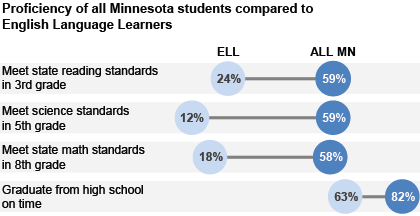
Looking ahead, continued economic vitality in our state will depend on an emerging workforce with diverse skills and preparation. This requires intentional thought and concerted effort around the inherent strengths and emergent challenges experienced by our immigrant communities.
Underscoring these strengths, challenges, and diversity across groups, new results from Speaking for Ourselves: A Study with Immigrant and Refugee Communities in the Twin Cities are now in the Compass library. Ongoing work on this study has provided up-to-date information on the experiences of unique immigrant and refugee groups who live here.
